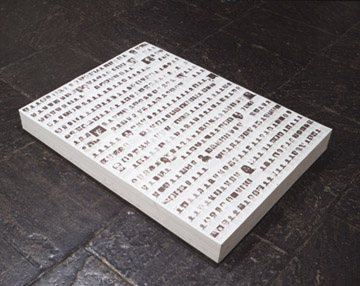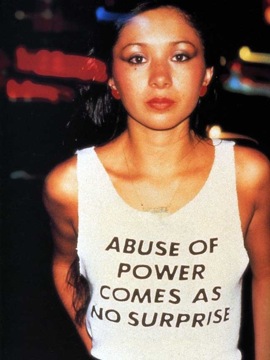
To continue from my first post, at Artistic Noise, we teach a curriculum that focuses on issues relevant to the lives of incarcerated and system-involved youth and uses art to encourage them to develop his or her voice. For every topic we explore, we study the work of contemporary artists who are creating work related to the one at hand. Our use of contemporary art can be as in-depth as creating an artwork inspired by an original piece or as simple as a daily check-in question. We have the luxury of ninety-minute classes to explore a different idea about contemporary artwork in almost every session.
Violence is something that affects so many of these teens. On a recent field trip to MoMA, we looked at, and took back with us, Felix Gonzalez-Torres’s “Untitled” (Death by Gun). Our students used his poster-sized artwork to create books with their own views on gun violence. We have also explored Walid Ra’ad‘s work, Oh, God, He Said Talking to a Tree, while discussing the issue of violence. Through these in-depth discussions, the students explore why contemporary artists, such as Gonzalez-Torres and Ra’ad, choose the materials and imagery they do to convey their idea, meaning, or message.

Felix Gonzalez-Torres. "'Untitled'" (Death by Gun)," 1990.
In our art and entrepreneurship studio, we have an entire wall of examples of contemporary artwork. Our programs are based on the Restorative Justice philosophy, in which we begin and end every group in a circle with a check-in question and a check-out question. Quite often, our check-in question will relate to the contemporary art wall. Recently, we asked students to choose a piece and say one word that they felt described it. One of the boys chose a photo of a woman wearing a shirt with the Jenny Holzer truism stating ABUSE OF POWER COMES AS NO SURPRISE. The discussion about the artwork was lively, excited, and involved. Not knowing that this piece was part of a series entitled Truisms, the young man described the work as “the truth.”

Jenny Holzer, "Truisms," 1977–79. T-shirt worn by Lady Pink, New York, 1983.
Artistic Noise is also partnering with a GED program that works a similar population. With the teachers, we create art curriculum to reinforce what they are working on in their regular class. This past fall, they had their students studying anatomy. After a visit to the Bodies exhibit with the teachers and their students, we began to cast the students’ faces and arms. We studied the art of Kiki Smith closely. One young woman cast her face and spent weeks painting it. She must have painted 15 coats on her mask. She was inspired by one of Smith’s works and added tears coming from her own eyes accompanied by her own words.
On a different trip to MoMA while working on this project, this same student saw Specter of Gardenia by Marcel Jean—a plaster head with eyes zippered shut. Since then, the student has begun to expand her body of work in a much more focused manner. In her artist’s statement for a linocut she wrote:
If you look in my eyes, what do you see? Pain, hurt, lies, darkness, and more. Just by looking at her you will start to understand her story. You will begin to feel her pain, hear her lies and become one with her in her world of darkness.
Working with art allows these students to express themselves, as well as consider different approaches artists employ to communicate in general and advocate for change specifically.
Lauren Adelman is an artist educator living in Brooklyn, New York. Lauren co-founded the non-profit organizations H.U.M.A.N. (Hear Us Make Artistic Noise) in Boston and Artistic Noise in NY, which bring visual arts and entrepreneurship to incarcerated and formerly incarcerated youth. Lauren is also a freelance educator for MoMA and has been an artist-in-residence in many different settings, including professional printmaking studios and detention and residential centers.



